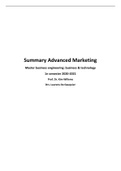Summary Advanced Marketing
Master business engineering: business & technology
1e semester 2020-2021
Prof. Dr. Kim Willems
Drs. Laurens De Gauquier
,Part 0. Introduction of the course (HOC 1)
1. Personal introduction
Lectures: prof. dr. Kim Willems (kim.willems@vub.be – office PL5.3.50)
Practice sessions: drs. Laurens De Gauquier (laurens.de.gauquier@vub.be – PL.3.52)
2. Course introduction
2.1. Objectives
Course objective
- Marketing discipline at large
- Marketing principles
- Trends and topics in marketing
- Solving marketing problems
- Sell your marketing ideas to the board
This course:
- Marketing discipline at large
o everything turns around customer value
o marketing = selling?
o consumer = customer?
- Marketing principles
o 4P’s: look at academic research on these
olink 4P’s to customer value
▪ Creating customer value is about coming up with a product or service that
has value to the customer, it answers a customer problem, it offers a
solution to a customer need
▪ Promotion is about communicating customer value, letting the market know
that you exist with your brand and let them know why you are preferable
over competitive brands and also convert potential consumer to customers
▪ Delivering customer value is about thinking strategically about the place,
how can the distribution channel be used to get my valuable offer to the
customer
▪ Price is exchanging the customer value, we want to offer customers
something of value, but we also want something in return, in many cases
profit
- Trends and topics in marketing
o About digital, social media marketing and new channels to sell your product
o About value co-creation and the effects on marketing
2
, - Solving marketing problems (use numbers and visualization)
o Importance performance analysis
o Customer equity calculations to calculate return on investment in marketing
- Sell your marketing ideas to the board
o Visualizing your ideas
o Marketing accountability: return on marketing investments?
o Proving acknowledgeable, backbone to support your ideas
2.2. Lectures & practical sessions
Topics
- Core ideas, principles and models in marketing
- Traditional vs (post-)modern marketing in the 21th century
- Marketing & Science
- B2B vs. B2C value creation (SD-logic, value co-creation…)
- Branding (brand equity, customer engagement, social media branding…)
- Omnichannel value delivery (mobile commerce, social commerce…)
- New media for value communication
- Marketing in pandemic times
- Selling your ideas to the board (return on marketing investments – ROMI, customer equity
service profit chain…)
- Best practices vs marketing failures…
Practical sessions
- Deepen your marketing insights beyond the knowledge presented in traditional, basic
marketing textbooks
- Sharpen your skills both in identifying links between the course theory and the everyday
business context
- Understand and apply marketing theories and toolkit to solve business problems
- Strengthen your functioning in teamwork
- Improve your analytical and reporting skills
2.3. Course material
Powerpoint slides regarding both the theoretical part as well as the practical part (and guest lecture)
Academic papers: articles that provide more in-depth insights to the theory presented in the slides
No textbook
2.4. Evaluation criteria
Lectures (70%)
- Written, closed-book exam: open questions + MPC questions (proof exam questions later)
- Optional: bonus questions & participation to scientific studies
Practice sessions : group assignment (30%)
- 10% assignment 1 (value enhancers) - 10% assignment 2 (summary papers & guest lectures)
- 10% assignment 3 (customer equity)
3
, Part 1. Marketing recap
1. Marketing
1.1. Conceptualization of the discipline
Marketing is…
- ‘the activity, set of institutions, and processes for creating, communicating, delivering, and
exchanging offerings that have value for customers, clients, partners, and society at large’
- ‘the management process of anticipating, identifying and satisfying customer requirements
profitably’
o ‘If I had asked people what they wanted, they would have said faster horses’ – Henry
Ford
Marketing as exchange
- It is a two-way (dyadic) process
o Most common interaction
is (b), it is a B2C, but there
are many kinds of
transactions in marketing
o (c): B2B transaction
o (a): non-profit interaction
Preconception 1: marketing = only for
products?
- Not only for products, also used
o For services (example: travel company) (cf. lecture 3)
o During the presidential elections: marketing around a campaign to make people
aware and to obtain votes
o For city, region or country branding (example: Antwerpen)
Preconception 2: marketing = sales?
- ‘The aim of marketing is to know and understand the customer so well the product or
service fits him and sells itself.’ – Peter Drucker
o Example: Duvel: they never do price promotions (but sometimes they give a
premium on top) → customer wants it anyway, no need to sale it
Marketing Sales
Tends towards long-term satisfaction of Tends towards short-term satisfaction of
customer needs customer needs; part of the value delivery
process as opposed to designing and
development of customer value processes
Tends to greater input into customer design of Tends to lesser input into customer design of
offering (co-creation) offering (co-creation)
Tends to high focus on stimulation of demand Tends to low focus on stimulation of demand,
more focused on meeting existing demand
Cf. relational vs. transactional marketing
Cf. goods- vs. Service-dominant logic (cf. lecture 4)
4




